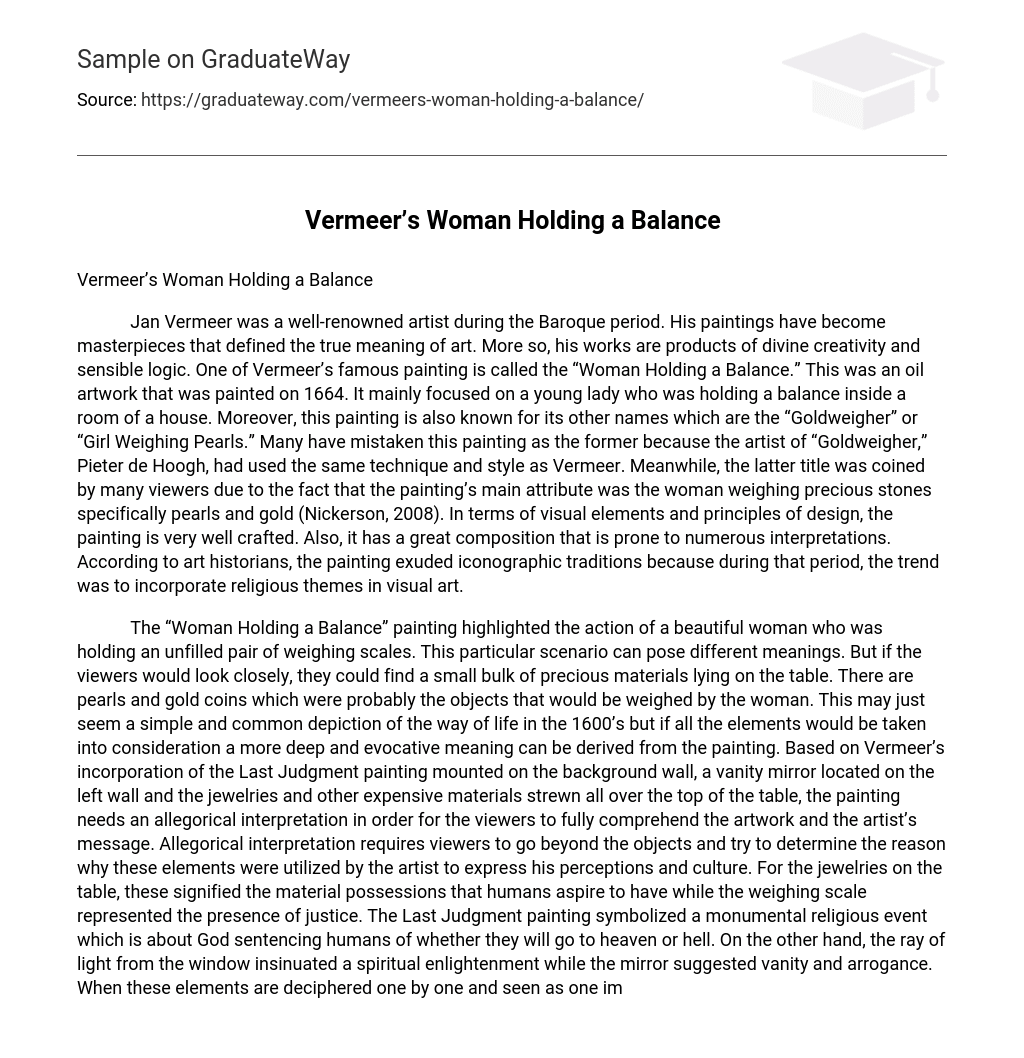Jan Vermeer was a well-renowned artist during the Baroque period. His paintings have become masterpieces that defined the true meaning of art. More so, his works are products of divine creativity and sensible logic. One of Vermeer’s famous painting is called the “Woman Holding a Balance.” This was an oil artwork that was painted on 1664. It mainly focused on a young lady who was holding a balance inside a room of a house. Moreover, this painting is also known for its other names which are the “Goldweigher” or “Girl Weighing Pearls.” Many have mistaken this painting as the former because the artist of “Goldweigher,” Pieter de Hoogh, had used the same technique and style as Vermeer. Meanwhile, the latter title was coined by many viewers due to the fact that the painting’s main attribute was the woman weighing precious stones specifically pearls and gold (Nickerson, 2008). In terms of visual elements and principles of design, the painting is very well crafted. Also, it has a great composition that is prone to numerous interpretations. According to art historians, the painting exuded iconographic traditions because during that period, the trend was to incorporate religious themes in visual art.
The “Woman Holding a Balance” painting highlighted the action of a beautiful woman who was holding an unfilled pair of weighing scales. This particular scenario can pose different meanings. But if the viewers would look closely, they could find a small bulk of precious materials lying on the table. There are pearls and gold coins which were probably the objects that would be weighed by the woman. This may just seem a simple and common depiction of the way of life in the 1600’s but if all the elements would be taken into consideration a more deep and evocative meaning can be derived from the painting. Based on Vermeer’s incorporation of the Last Judgment painting mounted on the background wall, a vanity mirror located on the left wall and the jewelries and other expensive materials strewn all over the top of the table, the painting needs an allegorical interpretation in order for the viewers to fully comprehend the artwork and the artist’s message. Allegorical interpretation requires viewers to go beyond the objects and try to determine the reason why these elements were utilized by the artist to express his perceptions and culture. For the jewelries on the table, these signified the material possessions that humans aspire to have while the weighing scale represented the presence of justice. The Last Judgment painting symbolized a monumental religious event which is about God sentencing humans of whether they will go to heaven or hell. On the other hand, the ray of light from the window insinuated a spiritual enlightenment while the mirror suggested vanity and arrogance. When these elements are deciphered one by one and seen as one image, the real meaning of the painting which is about the choice to live a life in moderation that is away from the temptations of worldly possessions can be easily understood. This symbolism was further enhanced by the angelic and serene facial expression of the woman which is similar to the quaint image of the Virgin Mary that showed that any individual can acquire good morals and right conduct (National Gallery of Art, 2008).
In order to accentuate the imagery represented by the painting, the artist used different types of colors and lighting. Vermeer utilized the contrast of bold and dark colors against soft and dim lighting to add harmony as well as drama into the picture. The subtle alteration of “light and shade and the rhythm established by the color relations” added up to the enhancement of the whole picture: the dark blue jacked worn by the woman had helped in the visibility of the several objects placed on the table. Meanwhile, “the color of the curtain on the left reverberates in the ochre tones on the table, the orange and yellow of the woman’s stomach and in the verticals of the picture frame on the far wall.” Furthermore, the woman’s facial expression merged with the precise geometrical composition which is an effect of the ray of light “entering from the window” provided a quality of sophistication (Vergara, 2003, p. 254). In the end, Vermeer wanted to convey a positive message of having a decent and well-rounded life that is free from temptations.
References
National Gallery of Art. (2008). Vermeer. Retrieved November 15, 2008, from http://www.nga.gov/feature/vermeer/symbols1.shtm
Nickerson, S. (21 October 2008). Johannes Vermeer’s Woman Holding a Balance Painting. Retrieved November 15, 2008, from http://www.associatedcontent.com/article/1107147/johannes_vermeers_woman_holdi ng_a_balance.html?page=1&cat=2
Vergara, A. (2003). Vermeer and the Dutch Interior. London: Paul Holberton.





